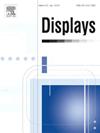通过识别RGB族色彩空间改进图像显示
IF 3.7
2区 工程技术
Q1 COMPUTER SCIENCE, HARDWARE & ARCHITECTURE
引用次数: 0
摘要
为了显示图像,假设图像编码所在的颜色空间是已知的。不幸的是,这种假设很少是现实的。在本文中,我们提出使用像素嵌入和高斯过程来识别给定彩色图像的颜色空间。支持五种颜色空间,即Adobe RGB, Apple RGB, ColorMatch RGB, ProPhoto RGB和sRGB。使用DRESDEN (Gloe and Böhme, 2010)和RAISE (Dang-Nguyen et al., 2015)图像集,我们实现了68%的识别率,强调需要在这个问题上进一步开展工作。本文章由计算机程序翻译,如有差异,请以英文原文为准。
Improved image display by identifying the RGB family color space
To display an image, the color space in which the image is encoded is assumed to be known. Unfortunately, this assumption is rarely realistic. In this paper, we propose to identify the color space of a given color image using pixel embedding and the Gaussian process. Five color spaces are supported, namely Adobe RGB, Apple RGB, ColorMatch RGB, ProPhoto RGB and sRGB. Using the DRESDEN (Gloe and Böhme, 2010) and RAISE (Dang-Nguyen et al., 2015) image collections, we achieve an identification rate of 68%, highlighting the need for further work on this issue.
求助全文
通过发布文献求助,成功后即可免费获取论文全文。
去求助
来源期刊

Displays
工程技术-工程:电子与电气
CiteScore
4.60
自引率
25.60%
发文量
138
审稿时长
92 days
期刊介绍:
Displays is the international journal covering the research and development of display technology, its effective presentation and perception of information, and applications and systems including display-human interface.
Technical papers on practical developments in Displays technology provide an effective channel to promote greater understanding and cross-fertilization across the diverse disciplines of the Displays community. Original research papers solving ergonomics issues at the display-human interface advance effective presentation of information. Tutorial papers covering fundamentals intended for display technologies and human factor engineers new to the field will also occasionally featured.
 求助内容:
求助内容: 应助结果提醒方式:
应助结果提醒方式:


